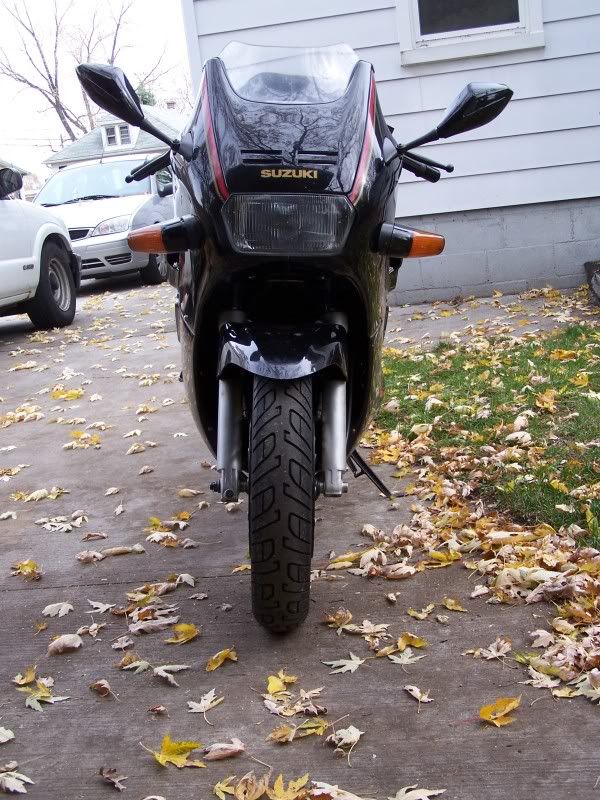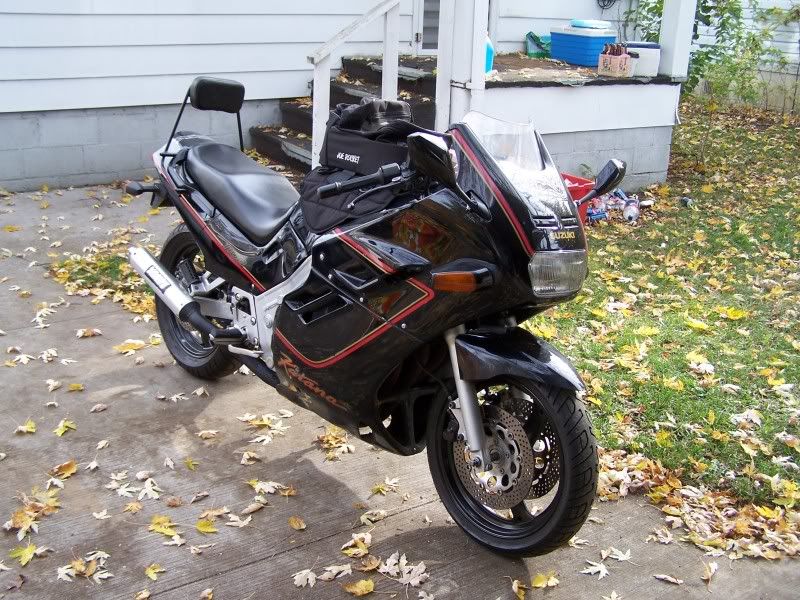I have read of a few people converting to 17" wheels here and decided it was time to have a go at it. I had a set of 600 kat wheels of the 90s vintage, with new shinko tires, and was really sick of fighting the bike into the corners. After measuring it all up it was quite simple as the 600 parts are a touch smaller than the 1100 stuff.
The 600 front axle is smaller, and the brake offset is narrower; but the 600 speedo drive is the same and the 600 brake calipers are a good match to the 1100 master cylinder. I turned up reducers to fit in the fork legs and made a new axle as the 1100 fork width is wider than the 600. It does appear that one could also swap the bearings in the 600 wheel with the 1100 bearings and use 1100 axle and parts but I did not go that route. I prefer to use the smaller axles. I used the 600 calipers and discs and made adapters from aluminum plate. The offset required is just under .500" so it was a matter of drilling some holes and a couple of spot faces.
The rear axle is also smaller but the 600 wheel with the stock cush drive spacers sits centered in the swingarm. I used the 1100 brake and axle adjusters, and 600 wheel, rotor, brake arm, axle. I turned up reducers for the axle, and made new spacers for the brake side. I also made a caliper mount from .250" aluminum plate. The 600 brake arm had to be shortened slightly and bent a little more but shares the same bolt sizes as the 1100 and the cush drive had to have the sprocket set back about .100". Again it appears that you could swap the bearings and use the 1100 axle and spacer on the 600 wheel.
I also went down to a 530 chain with a 16T front and a 47t rear.
All I can say is WOW what a difference. The bike actually feels like it is geared properly, and it turns in without hesitation. It maintains any corner line and feels planted and nimble. I rode two up all weekend and never wanted to get off of it.
With the availability of 600 kat wheels at cheap prices and the near bolt in if you swap bearings I don't know why others are not doing this. It by far is worth the effort.
The 600 front axle is smaller, and the brake offset is narrower; but the 600 speedo drive is the same and the 600 brake calipers are a good match to the 1100 master cylinder. I turned up reducers to fit in the fork legs and made a new axle as the 1100 fork width is wider than the 600. It does appear that one could also swap the bearings in the 600 wheel with the 1100 bearings and use 1100 axle and parts but I did not go that route. I prefer to use the smaller axles. I used the 600 calipers and discs and made adapters from aluminum plate. The offset required is just under .500" so it was a matter of drilling some holes and a couple of spot faces.
The rear axle is also smaller but the 600 wheel with the stock cush drive spacers sits centered in the swingarm. I used the 1100 brake and axle adjusters, and 600 wheel, rotor, brake arm, axle. I turned up reducers for the axle, and made new spacers for the brake side. I also made a caliper mount from .250" aluminum plate. The 600 brake arm had to be shortened slightly and bent a little more but shares the same bolt sizes as the 1100 and the cush drive had to have the sprocket set back about .100". Again it appears that you could swap the bearings and use the 1100 axle and spacer on the 600 wheel.
I also went down to a 530 chain with a 16T front and a 47t rear.
All I can say is WOW what a difference. The bike actually feels like it is geared properly, and it turns in without hesitation. It maintains any corner line and feels planted and nimble. I rode two up all weekend and never wanted to get off of it.
With the availability of 600 kat wheels at cheap prices and the near bolt in if you swap bearings I don't know why others are not doing this. It by far is worth the effort.















Comment